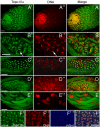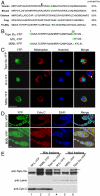Drosophila topo IIIalpha is required for the maintenance of mitochondrial genome and male germ-line stem cells
- PMID: 20308575
- PMCID: PMC2852012
- DOI: 10.1073/pnas.1001855107
Drosophila topo IIIalpha is required for the maintenance of mitochondrial genome and male germ-line stem cells
Abstract
Topoisomerase IIIalpha (topo IIIalpha), a member of the conserved Type IA subfamily of topoisomerases, is required for the cell proliferation in mitotic tissues, but has a lesser effect on DNA endoreplication. The top3alpha gene encodes two forms of protein by utilizing alternative translation initiation sites: one (short form) with the nuclear localization signal only, exclusively localized in the nuclei, and the other (long form), retaining a mitochondrial import sequence at the N-terminus and the nuclear localization sequence at the C-terminus, localized primarily in the mitochondria, though with a small portion in the nuclei. Both forms of topo IIIalpha can rescue the viability of null mutants of top3alpha. No apparent defect is associated with the flies rescued by the long form; short-form-rescued flies (referred to as M1L), however, exhibit defects in fertilities. M1L females are sterile. They can lay eggs but with mitochondrial DNA (mtDNA) copy number and ATP content decreased by 20- and 2- to 3-fold, respectively, and they fail to hatch. Of the newly eclosed M1L males, 33% are completely sterile, whereas the rest have residual fertilities that are quickly lost in 6 days. The fertility loss of M1L males is caused by the disruption of the individualization complex and a progressive loss of germ-line stem cells. This study implicates topo IIIalpha in the maintenance of mtDNA and male germ-line stem cells, and thus is a causative candidate for genetic disorders associated with mtDNA depletion.
Conflict of interest statement
The authors declare no conflict of interest.
Figures





Similar articles
-
Drosophila mitochondrial topoisomerase III alpha affects the aging process via maintenance of mitochondrial function and genome integrity.J Biomed Sci. 2016 Apr 12;23:38. doi: 10.1186/s12929-016-0255-2. J Biomed Sci. 2016. PMID: 27067525 Free PMC article.
-
Drosophila melanogaster topoisomerase IIIalpha preferentially relaxes a positively or negatively supercoiled bubble substrate and is essential during development.J Biol Chem. 2005 Feb 4;280(5):3564-73. doi: 10.1074/jbc.M411337200. Epub 2004 Nov 10. J Biol Chem. 2005. PMID: 15537633
-
Dual localization of human DNA topoisomerase IIIalpha to mitochondria and nucleus.Proc Natl Acad Sci U S A. 2002 Sep 17;99(19):12114-9. doi: 10.1073/pnas.192449499. Epub 2002 Sep 3. Proc Natl Acad Sci U S A. 2002. PMID: 12209014 Free PMC article.
-
DNA topoisomerases in mtDNA maintenance and ageing.Exp Gerontol. 2014 Aug;56:135-41. doi: 10.1016/j.exger.2014.01.009. Epub 2014 Jan 15. Exp Gerontol. 2014. PMID: 24440386 Review.
-
Mitochondrial topoisomerases and alternative splicing of the human TOP1mt gene.Biochimie. 2007 Apr;89(4):474-81. doi: 10.1016/j.biochi.2006.11.002. Epub 2006 Nov 27. Biochimie. 2007. PMID: 17161897 Review.
Cited by
-
Advanced Parental Age at Conception and Sex Affects Mitochondrial DNA Copy Number in Human and Fruit Flies.J Gerontol A Biol Sci Med Sci. 2019 Nov 13;74(12):1853-1860. doi: 10.1093/gerona/glz070. J Gerontol A Biol Sci Med Sci. 2019. PMID: 30874797 Free PMC article.
-
Human topoisomerases and their roles in genome stability and organization.Nat Rev Mol Cell Biol. 2022 Jun;23(6):407-427. doi: 10.1038/s41580-022-00452-3. Epub 2022 Feb 28. Nat Rev Mol Cell Biol. 2022. PMID: 35228717 Free PMC article. Review.
-
Physiological Roles of DNA Double-Strand Breaks.J Nucleic Acids. 2017;2017:6439169. doi: 10.1155/2017/6439169. Epub 2017 Oct 18. J Nucleic Acids. 2017. PMID: 29181194 Free PMC article. Review.
-
Essential functions of C terminus of Drosophila Topoisomerase IIIα in double holliday junction dissolution.J Biol Chem. 2012 Jun 1;287(23):19346-53. doi: 10.1074/jbc.M112.363044. J Biol Chem. 2012. PMID: 22511792 Free PMC article.
-
Top3α is the replicative topoisomerase in mitochondrial DNA replication.Nucleic Acids Res. 2022 Aug 26;50(15):8733-8748. doi: 10.1093/nar/gkac660. Nucleic Acids Res. 2022. PMID: 35904803 Free PMC article.
References
-
- Schoeffler AJ, Berger JM. DNA topoisomerases: Harnessing and constraining energy to govern chromosome topology. Q Rev Biophys. 2008;41(1):41–101. - PubMed
-
- Wang JC. Cellular roles of DNA topoisomerases: A molecular perspective. Nat Rev Mol Cell Biol. 2002;3(6):430–440. - PubMed
-
- Plank JL, Chu SH, Pohlhaus JR, Wilson-Sali T, Hsieh TS. Drosophila melanogaster topoisomerase IIIalpha preferentially relaxes a positively or negatively supercoiled bubble substrate and is essential during development. J Biol Chem. 2005;280(5):3564–3573. - PubMed
Publication types
MeSH terms
Substances
Grants and funding
LinkOut - more resources
Full Text Sources
Medical
Molecular Biology Databases

